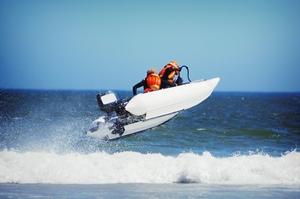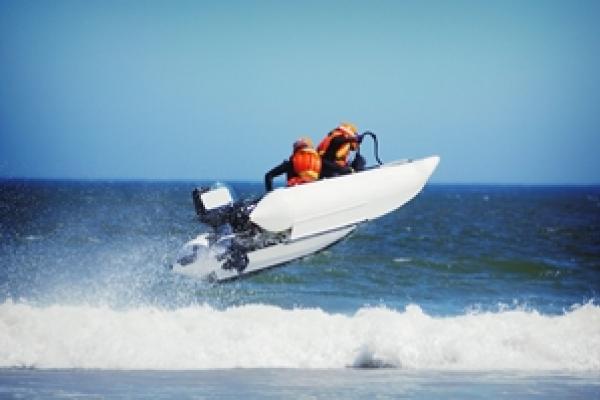
Steamship Mutual
Published: November 01, 2013

A recent judgment of the Scottish Court in Cairns v Northern Lighthouse Board [2013] CSOH has brought into sharp focus the risks associated with the use of small, powerful boats in rough seas. Although in this case the vessel involved was being operated for commercial hire, many of our members’ vessels will be fitted with Rescue Craft or Fast Rescue Craft which present similar hazards.
Summary
The claimant was employed in the finance department of the Northern Lighthouse Board (NLB) and part of her work entailed auditing the fixed assets of the defendants, including those assets in NLB’s lighthouses. On this particular occasion, the claimant was obliged to travel to an island lighthouse situated approximately 5 miles off the coast in order to carry out such an audit. The first defendant engaged the service of a third-party boat owner (the second defendant) to take the claimant and others from the shore to the lighthouse and in doing so the second defendant utilised a Rigid Inflatable Boat (RIB). Shortly after leaving the calm of the harbour, the boat met with rough seas and – as a result of travelling at excessive speed relative to the height of the waves being encountered – the boat climbed a wave before falling sharply and slamming into the water. The resultant impact led to the claimant injuring her lower back.
The UK’s Marine Accident Investigation Branch (MAIB) has investigated two similar accidents in recent years – on a 9-metre rigid inflatable boat in 2008 and on a Delta RIB in May 2010, both of which resulted in a passenger suffering lower back compression injuries – they also report a total of 40 similar incidents between 2001 and 2010.
The Legal Position
The claimant raised a claim for damages against both her employer and the third-party boat owner under the Merchant Shipping and Fishing Vessels (Health and Safety at Work) Regulations 1997, and more specifically reg. 5(1) - which imposes a strict duty on employers to “ensure the health and safety of workers and other persons so far as is reasonably practicable, which duty shall be met by the application of the following principles:
(a) the avoidance of risks, which among other things include the combating of risks at source and the replacement of dangerous practices, substances or equipment by non-dangerous or less dangerous practices, substances or equipment;
(b) the evaluation of unavoidable risks and the taking of action to reduce them;
(c) adoption of work patterns and procedures which take account of the capacity of the individual, especially in respect of the design of the workplace and the choice of work equipment, with a view in particular to alleviating monotonous work and to reducing any consequent adverse effect on workers' health and safety;
(d) adaptation of procedures to take account of new technology and other changes in working practices, equipment, the working environment and any other factors which may affect health and safety;
(e) adoption of a coherent approach to management of the vessel or undertaking, taking account of health and safety at every level of the organisation;
(f) giving collective protective measures priority over individual protective measures; and
(g) the provision of appropriate and relevant information and instruction for workers.”
Subsidiary to the main claim, the claimant pleaded a common law case.
Decision
The first defendant, as the claimant’s employer, very clearly had a duty under reg. 5, whereas under reg. 5 alone the second defendant did not, on the basis that they were not the claimant’s ‘employer’. In determining that the second defendant was liable under the 1997 regulations, the Court looked to reg. 4(2) which provides that "where an employer does not have control of the matter to which the regulation relates because he does not have responsibility for the operation of the ship, then any duty imposed by that regulation shall also extend to any ... person who has control of that matter". The effect of which is to extend the duty of an ‘employer’ to any person in control of a ship and thus also to the second defendant.
The only defence to a claim brought under legislation imposing strict liability for the health and safety of workers is the defence of “reasonable practicability”, which is to say that the employer has taken all reasonable measures to ensure health and safety, taking into account and weighing up all relevant matters. In fact, neither of the defendants raised the 'reasonable practicability' defence, nor did they present any evidence in support of such a defence; accordingly, both defendants were held jointly and severally liable, with the second defendant being found liable to indemnify the first defendant in full under the terms of the service contract.
As the claim succeeded under the statutory legislation, the common law position was of no practicable significance. Nevertheless, the alleged negligence of the second defendant was considered. Firstly, it was deemed unnecessary for the claimant to travel that day when the weather conditions were poor and forecast to deteriorate. Secondly, not enough was done to reduce the risk of injury: by way of a reduction in speed, or by providing the claimant with adequate instruction on seating and bracing positions so as best to avoid the risk of injury.
It is noteworthy that in summation Lord Drummond Young observed that accidents at work are invariably caught by legislation designed to protect the health and safety of workers. As such, he expressed doubt as to any material advantage which could be gained in continuing to plead a common law case where health and safety legislation clearly applied. Indeed, he went so far as to say that counsel should be encouraged to base claims on the relevant legislation, since adding an alternative claim under common law serves only to increase significantly the amount of expert evidence required. Such a proposal ought to be welcomed by our members for the obvious cost savings this would bring should they find themselves facing a claim of a similar nature.
Practical Implications
Once it was established that both defendants owed the claimant a duty under the 1997 regulations, the judge turned to the expert led evidence of both sides when considering liability.
Both experts agreed that the risk of slamming can be avoided by reducing speed and on the facts the helmsman had driven too fast given the prevailing sea state. A notable feature of this type of craft is their “power to weight ratio”: they have a relatively small displacement coupled with what may be a powerful engine. In more severe weather conditions this can mean that the shocks and vibrations, resulting from the impacts between a boat’s hull and the surface of the water, are transmitted through the deck and seats to the boat’s occupants. This is known as ‘whole-body vibration’ (WBV) and limits have been set to reduce the possibility for injuries. It has been found in testsi that the occupants of a fast rescue boat travelling at 40 knots in a sea state of between 1 and 2 were exposed to constant shocks in the region of 2g, regular shocks in the region of 6g and occasional shocks of up to 20g. These can cause an increase in spinal, knee, arm, or neck injury from either a single high energy event (e.g. a single 20g impact) or as a result of long-term exposure to a large quantity of smaller energy events (e.g. multiple 2g impacts).
Fast Rescue Craft personnel can, to a degree, limit the effect of shock exposure to the lower back by bracing the body against impact and supporting the weight of their body through their arms and legs. However, the main factor affecting boat performance, and therefore shock exposure, is throttle response – i.e. reducing power before reaching the top of a wave and so preventing the boat from becoming airborne. In practice, the helmsman’s ability to ‘read’ the sea conditions, to slow down in a timely manner and operate the boat for the comfort and safety of the passengers is based on their skill, training and experience.
In the above case it was posited that in the absence of any urgency for the audit to be conducted, the voyage could have been delayed until such a time as the weather conditions were more suitable. The implication of this finding for members is that it is incumbent on the masters of their vessels to make a proper assessment of the sea conditions and weather forecast when determining whether it is safe to conduct routine operations in Rescue Craft.
The judge was also critical of the safety briefing provided by the second defendant. When making a risk assessment of any Rescue Craft operation, members should give proper consideration to the training and experience of both crew and passengers and appropriate safety instructions issued accordingly. Members will be aware that the 2010 Manila Amendments to the International Convention on Standards of Training, Certification and Watchkeeping for Seafarers, 1978 makes provision for Certificates of Proficiency in (Fast) Rescue Craft. In particular, Table A-VI/2-2 describes the minimum standard of competence required. Part of the training highlights the dangers of excessive speed in worsening weather conditions and of inadequate seating arrangements.
Although not a factor in the Cairns case, members and their crews are reminded of the vital role that emergency release switches (‘kill cords’) have in Fast Rescue Craft operations. The cord serves only one purpose: to stop the engine when the driver moves away from the controls. To operate correctly and be a safety feature that Fast Rescue Craft crews can have confidence in, it is necessary for the cord to be in good condition, to be tested before the boat is put into gear, and to always be attached securely to the driver. A number of recent accidents, including fatalities, have unfortunately demonstrated this simple yet effective safety device is not being used effectively.
The decision in Cairns can be found at:http://www.scotcourts.gov.uk/opinions/2013CSOH22.html
i “High Speed Craft Human Factors Engineering Design Guide”, published in 2008 by the ABCD Working Group on Human Performance at Sea – an ad-hoc international group consisting of researchers of hydrodynamics and human factors from the US, Australia, the UK, Canada, and the Netherlands.


